

Seeing Theory - Probability and statistics.
Online Statistics Education: A Free Resource for Introductory Statistics. Developed by Rice University (Lead Developer), University of Houston Clear Lake, and Tufts University OnlineStatBook Project Home This work is in the public domain.
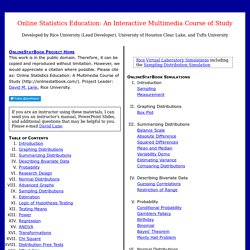
Therefore, it can be copied and reproduced without limitation. However, we would appreciate a citation where possible. Yao Xie - Teaching. Probability and Statistics: an introduction. Probability for Math Science: UCLA Math 3C [Complete] Bayesian statistics - OpenLearn - Open University - M249_2. Introduction to Probability - Open Textbook Library. This text provides very good coverage of the essential topics for an introductory probability course in addition to its coverage of topics that I’m sure are left out of some introductory courses such as Markov processes and generating functions.
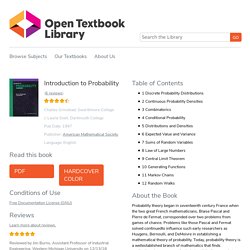
The strength of this book in my view (which is from an engineering perspective) is that it approaches topics in a very natural way, using practical examples, simple graphics, and discussion of computer simulation when introducing topics. It does not seem to burden the reader with statistical jargon or needlessly deep discussions of theory, but it does not give the impression that it is trying to avoid these things either. Home - Statistics LibreTexts. Electronics & Communication Engineering - NOC:Probability and Random Variables/ Processes for Wireless Communications. Online Statistics Education: A Free Resource for Introductory Statistics. Probability Course. Probability and Random Variables/ Processes for Wireless Communications. Probability and Random Variables / Processes for Wireless Communications - Course. Probability, Statistics and Random Processes. MIT 6.041SC Probabilistic Systems Analysis and Applied Probability, Fall 2013. MIT Course 9.520 - Statistical Learning Theory and Applications, Fall 2015.
Probability Lecture Videos by Joe Blitzstein (Harvard) Probability and Statistics. MATH 146 – Introduction to Statistics. In this course, we will introduce some of the more common tools for analyzing data of several types.

We are not aiming at introducing all or even most of them. The main goal of the course is to highlight the general assumptions and methods that underlie all statistical analysis. The purpose is to get a good understanding of the scope, and the limitations of these methods. We also want to learn as much as possible about the assumptions behind the most common methods, in order to evaluate if they apply with reasonable accuracy to a given situation. List of poker hands. An ace-high straight flush, commonly known as a royal flush, is the best hand possible in some variants of poker.
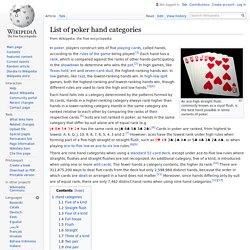
Each hand falls into a category determined by the patterns formed by its cards. Hands in a higher-ranking category always rank higher than hands in a lower-ranking category. Hands in the same category are ranked relative to each other by comparing the ranks of their respective cards.[5] Suits are not ranked in poker, so hands in the same category that differ by suit alone are of equal rank (e.g.
J♦ 8♦ 5♦ 3♦ 2♦ has the same rank as J♣ 8♣ 5♣ 3♣ 2♣).[6] Cards in poker are ranked, from highest to lowest: A, K, Q, J, 10, 9, 8, 7, 6, 5, 4, 3 and 2.[7] However, aces have the lowest rank under high rules when forming part of a five-high straight or straight flush, such as 5♥ 4♦ 3♣ 2♣ A♠ or 5♣ 4♣ 3♣ 2♣ A♣, or when playing ace-to-five low or ace-to-six low rules.[8][9] Hand categories[edit] Five of a kind[edit] Each five of a kind is ranked by the rank of its quintuplet.
Full house[edit] Simple Book Publishing. Copyright This courseware includes resources copyrighted and openly licensed by multiple individuals and organizations.

Click the words "Licenses and Attributions" at the bottom of each page for copyright and licensing information specific to the material on that page. If you believe that this courseware violates your copyright, please contact us. Cover Image: "Koi Kites. " Provided by: StockSnap. Introduction to Statistics.
MIT RES.6-012 Introduction to Probability. Sample Spaces Probability. Sample Space. Sample space. For example, if the experiment is tossing a coin, the sample space is typically the set {head, tail}.

For tossing two coins, the corresponding sample space would be {(head,head), (head,tail), (tail,head), (tail,tail)}, commonly written {HH, HT, TH, TT}. If the sample space is unordered, it becomes {{head,head}, {head,tail}, {tail,tail}}. For tossing a single six-sided die, the typical sample space is {1, 2, 3, 4, 5, 6} (in which the result of interest is the number of pips facing up).[5] Conditions of a sample space[edit] [6] A set with outcomes (i.e. ) must meet some conditions in order to be a sample space: The outcomes must be mutually exclusive, i.e. if takes place, then no other will take place, .The outcomes must be collectively exhaustive, i.e., on every experiment (or random trial) there will always take place some outcome for .The sample space () must have the right granularity depending on what we are interested in.
Midterm_review.
Probability in Genetics: Multiplication and Addition Rules. Introduction to STAT 414. Printer-friendly version As the title of Stat 414 suggests, we will be studying the theory of probability, probability, and more probability throughout the course.
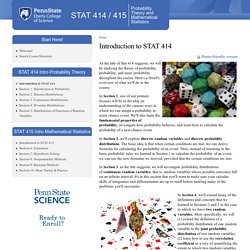
Here's a (brief!) Overview of what we'll do in the course: Index for Probability and Statistics. Binomial coefficients - Encyclopedia of Mathematics. Binomial coefficient. The binomial coefficients can be arranged to form Pascal's triangle, in which each entry is the sum of the two immediately above.
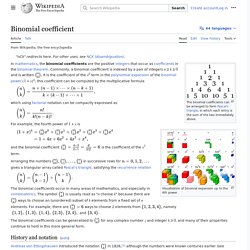
Visualisation of binomial expansion up to the 4th power In mathematics, any of the positive integers that occurs as a coefficient in the binomial theorem is a binomial coefficient.
Introduction to Probability. Untitled Document. This introductory probability book, published by the American Mathematical Society, is available from AMS bookshop.
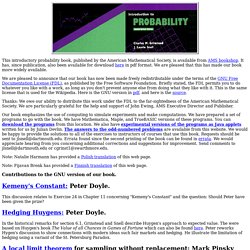
It has, since publication, also been available for download here in pdf format. We are pleased that this has made our book more widely available. We are pleased to announce that our book has now been made freely redistributable under the terms of the GNU Free Documentation License (FDL), as published by the Free Software Foundation. Briefly stated, the FDL permits you to do whatever you like with a work, as long as you don't prevent anyone else from doing what they like with it. This is the same license that is used for the Wikipedia.
Thanks: We owe our ability to distribute this work under the FDL to the far-sightedness of the American Mathematical Society. Our book emphasizes the use of computing to simulate experiments and make computations. Gambler's ruin. The Gambler's Ruin Problem. Making Sense of Understanding: The Three Doors of Serendip. The Three Doors of Serendip. Excel for Business Statistics. This is a webtext companion site ofBusiness StatisticsUSA Site Para mis visitantes del mundo de habla hispana, este sitio se encuentra disponible en español en: Sitio Espejo para América Latina Sitio de los E.E.U.U.

Excel is the widely used statistical package, which serves as a tool to understand statistical concepts and computation to check your hand-worked calculation in solving your homework problems. The site provides an introduction to understand the basics of and working with the Excel. Redoing the illustrated numerical examples in this site will help improving your familiarity and as a result increase the effectiveness and efficiency of your process in statistics.To search the site, try Edit | Find in page [Ctrl + f].
Enter a word or phrase in the dialogue box, e.g. To enter information into a cell, select the cell and begin typing. Excel For Introductory Statistical Analysis. Interactive Mathematics. Probability Problems. American Heritage Dictionary defines Probability Theory as the branch of Mathematics that studies the likelihood of occurrence of random events in order to predict the behavior of defined systems. (Of course What Is Random? Is a question that is not all that simple to answer.) StatCrunch - Data analysis on the Web. StatCrunch. Rice Virtual Lab in Statistics (RVLS) Partial support for this work was provided by the National Science Foundation's Division of Undergraduate Education through grant DUE 9751307.
Any opinions, findings, and conclusions or recommendations expressed in this material are those of the author(s) and do not necessarily reflect the views of the National Science Foundation. Last updated: 07/03/2018 19:56:11. Material Search Results. Find Open Textbooks. Hair Colour for Hairstylists: Level 2Author(s): Arden Magtiza, Vancouver Island UniversityUpdated: Feb 19, 2021Description: This manual serves as a guide for apprentices with the desire to stretch beyond their foundational colour knowledge and skills so as to reach a higher level of competency. This text will walk the stylist step-by-step through many current and advanced techniques used in the industry today. Accessible Elementary Algebra - 2e (OpenStax)Author(s): Lynn Marecek, Santa Ana College, MaryAnne Anthony-Smith, Formerly of Santa Ana College, Andrea Honeycutt Mathis, Northeast Mississippi Community CollegeUpdated: Feb 10, 2021Description: Elementary Algebra - 2e is designed to meet scope and sequence requirements for a one-semester elementary algebra course.
The book’s organization makes it easy to adapt to a variety of course syllabi. The text expands on the fundamental concepts of algebra while addressing the needs of students with diverse backgrounds and learning styles. Beginning Statistics - Table of Contents. Find Open Textbooks. Find Open Textbooks. OpenStax CNX. Rule of Sum and Rule of Product Problem Solving. This section includes the basic examples and problems that will warm you up for the next section of problem solving. Calvin wants to go to Milwaukee. He can choose from bus services or train services to head from home to downtown Chicago.
From there, he can choose from 2 bus services or 3 train services to head to Milwaukee. This time, he has to purchase a bus concession (which will only allow him to take buses), or a train concession (which will only allow him to take trains). Rule of product. Category:Combinatorics. The main article for this category is Combinatorics. Category:Statistics. Statistics.